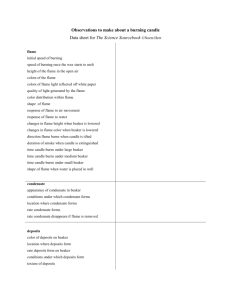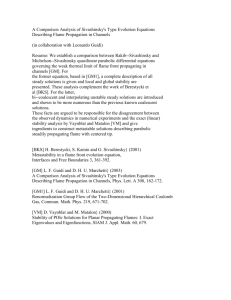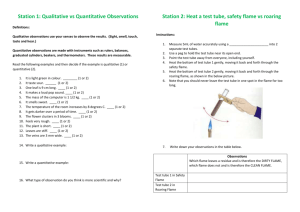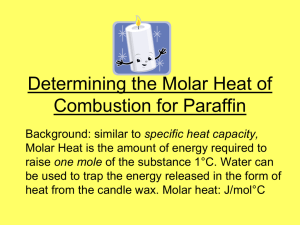Candle Lab
advertisement
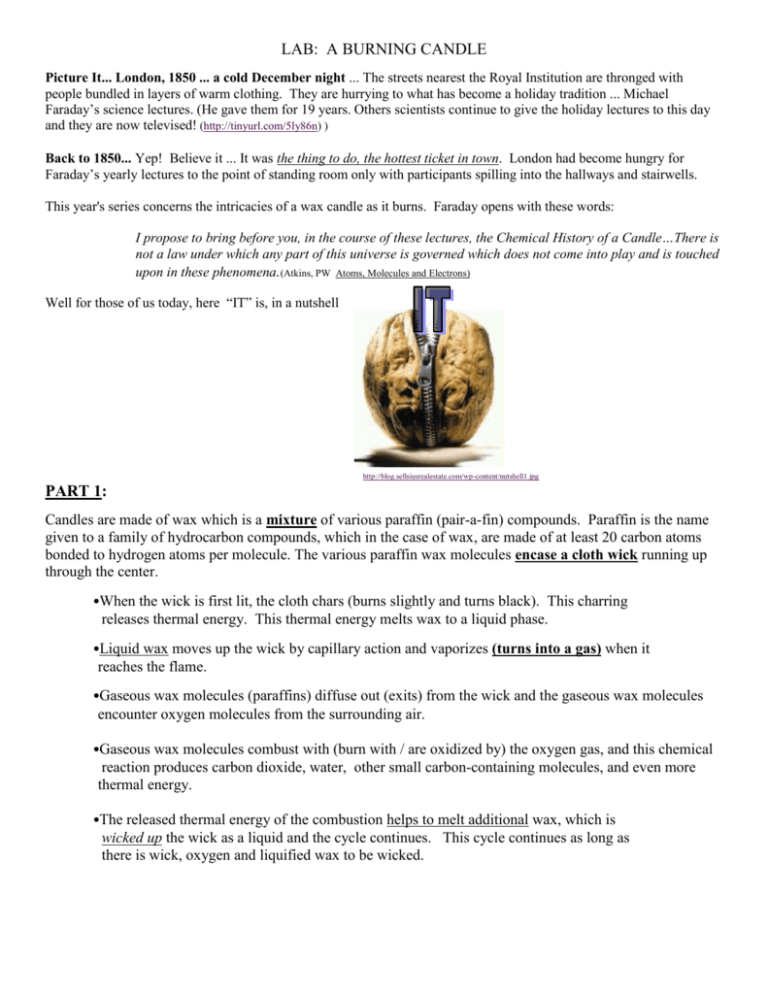
LAB: A BURNING CANDLE Picture It... London, 1850 ... a cold December night ... The streets nearest the Royal Institution are thronged with people bundled in layers of warm clothing. They are hurrying to what has become a holiday tradition ... Michael Faraday’s science lectures. (He gave them for 19 years. Others scientists continue to give the holiday lectures to this day and they are now televised! (http://tinyurl.com/5ly86n) ) Back to 1850... Yep! Believe it ... It was the thing to do, the hottest ticket in town. London had become hungry for Faraday’s yearly lectures to the point of standing room only with participants spilling into the hallways and stairwells. This year's series concerns the intricacies of a wax candle as it burns. Faraday opens with these words: I propose to bring before you, in the course of these lectures, the Chemical History of a Candle…There is not a law under which any part of this universe is governed which does not come into play and is touched upon in these phenomena.(Atkins, PW Atoms, Molecules and Electrons) Well for those of us today, here “IT” is, in a nutshell http://blog.sellsiusrealestate.com/wp-content/nutshell1.jpg PART 1: Candles are made of wax which is a mixture of various paraffin (pair-a-fin) compounds. Paraffin is the name given to a family of hydrocarbon compounds, which in the case of wax, are made of at least 20 carbon atoms bonded to hydrogen atoms per molecule. The various paraffin wax molecules encase a cloth wick running up through the center. •When the wick is first lit, the cloth chars (burns slightly and turns black). This charring releases thermal energy. This thermal energy melts wax to a liquid phase. •Liquid wax moves up the wick by capillary action and vaporizes (turns into a gas) when it reaches the flame. •Gaseous wax molecules (paraffins) diffuse out (exits) from the wick and the gaseous wax molecules encounter oxygen molecules from the surrounding air. •Gaseous wax molecules combust with (burn with / are oxidized by) the oxygen gas, and this chemical reaction produces carbon dioxide, water, other small carbon-containing molecules, and even more thermal energy. •The released thermal energy of the combustion helps to melt additional wax, which is wicked up the wick as a liquid and the cycle continues. This cycle continues as long as there is wick, oxygen and liquified wax to be wicked. PART 2 Students typically believe that only the wick is burning and not the (unseen) gaseous wax. They tend to believe that the burning candle becomes smaller, due to the wax simply melting and dribbling down the sides of the candle, as opposed to the wax chemically reacting to produce different compounds like carbon dioxide and water. Students fail to grasp that the gaseous wax is really undergoing a chemical reaction (not just a series of physical changes) in the presence of oxygen and it is being consumed and converted into carbon dioxide and water!!! The candle is getting smaller (and thus the overall mass of the candle is changing), because the products of the combusting candle (carbon dioxide and water) are allowed to escape into the atmosphere. [N.B. The LCME can only be upheld when the system is closed.] Additionally, students are confused by the various colors of a candle flame. In chemistry we are taught that the "blue of a Meker burner flame" indicates the hottest part of the flame. That concept is pretty much correct. We also know that the color of that blue flame is due to the excited/unexcited states of the electrons in the molecules of CO2(g) & H2O(g), as these products are made. Yet, there is a blue portion to a candle flame, but this blue, oxygen-rich zone at the bottom of the flame, is not the hottest part of the flame, surprisingly, nor is it due to carbon dioxide and water, really. This bottom blue light is probably the emission spectrum of small hydrocarbon (carbon and hydrogen ) molecules or fragments of molecules, as they bond. These may be temporary associations that are destroyed as the fragments enter the hotter portions of the flame. In the top of the flame, a hot, gaseous soup of small molecules gives off light as a molecular emission that appears yellow. This yellow color is due to the large number of carbon based materials in the flame (primarily), that are not fully oxidized (carbon has not be converted completely to a C+4 state of CO2(g)) . Carbon’s emission spectrum can be yellow in color. One small point of interest, is that only the yellow part of the flame casts a shadow; note the pale shadow cast against the wall in the flash photo below (Figure 1). It is important to note that: a disturbed flame produces black soot (solid carbon). When you blow a candle out, the flow of gas-phase wax (fuel) to the combustion zone is disrupted and the hot gases are dispersed, extinguishing the flame. Afterward, gaseous wax emerges from the hot wick for several seconds. You can see and smell the vaporized, then condensed, wax that appears as WHITE smoke. Figure 1 JCE 4 April 2008 So consider this following about a single wax candle flame: There is hard wax, melted wax, white vaporized wax, gaseous oxygen, black solid carbon, and various temperature zones of a flame with different color emissions This lab is used by permission. It was published in the Journal of Chemical Education (4 April 2008), in the activity A Candle In The Wind. It was written by Robert J. Eierman Dept. of Chemistry, University of Wisconsin–Eau Claire, Eau Claire, WI 54701; reierman@uwec.edu . It has been altered from its original form and content by your teacher. PURPOSE: Candles have a problem; they are unstable in the wind: they flicker and are easily blown out. What happens when you blow out a candle? What is a candle flame? With any combustion reaction, a candle flame balances three things: fuel, oxygen, and thermal energy. In this activity, you will investigate the secrets of how a candle balances those three necessities to create its beautiful light and how the flame can be extinguished by simply blowing on it. You will need to differentiate between what the authors consider to be a disturbed candle flame, an extinguished candle flame, and an undisturbed burning candle flame MATERIALS: You will need: candle that is free-standing or in a stable holder, several matches and wood splints, two index cards, and a container of water (in case things get out of hand!!). Please DO NOT put matches/wood into the sink. PROCEDURE: As you perform each part of the investigation, make careful observations and record them. 1. Briefly examine an unlit candle. What do the wax and wick look like? Record your observations. 2. Light the candle and observe it for at least one minute. Write down observations regarding the wick, wax, odor, flame etc... on your observation sheet Is there any odor? If yes, can you connect an experience or memory to the odor ... or can you identify the odor? Sketch the colors, shapes, and movements of the different parts of the flame, after one minute. How many different zones of color and/or areas of a flame can you see? Be sure your sketch indicates these zones in this space, you may need to refer back to it for your write-up. 3. DISTURB the flame by moving an index card horizontally (flat) slowly through the flame. Describe how the flame changes in appearance as you DISTURB the flame. Describe the appearance of the card’s bottom surface. 4. DISTURB the flame again, but by blowing gently on the flame a few times without blowing it out. Identify the color of the smoke of a disturbed candle flame. 5. EXTINGUISH or blow out the flame. Identify the color of the smoke of an extinguished candle flame. 6. Relight the candle and let it burn for 30 seconds. Light a wood splint with that flame. Hold the lit splint in your hand, blow out the candle, and immediately put the lit splint in the stream of white smoke about 0.5 in. to 1 in. above the wick. What happens? Why do you think this called the “jumping flame” trick? You need to be able to explain why/how this happens. Now, go ahead and play a little... My best distance is about 2.5 to 3 cm (a bit more than 1 inch) above the wick.... NAME__________________________________________________ WRITE / UP QUESTIONS (* must be completed) *1) Label the following flame diagram using the description of each zone, using the letters associated with each zone. (You may find the 5 descriptions below very helpful in answering the other questions.) There are 5 zones to the flame of a burning paraffin candle This zone is bright yellow. There is insufficient oxygen at this point to burn the fuel completely. Paraffin is split apart resulting in large carbon particles as products. Despite this lack of complete combustion, the temperature of the matter is around a surprising high 1,200 C. Label this zone as “L”. This zone is where the liquid fuel evaporates to gas. There is insufficient oxygen for the fuel to burn. The temperature is a cool 600 C. This zone is below the dark zone and surrounded by another zone, the blue portion of the flame. Label this zone as “E”. This zone has a surplus, (a ton, if you will) of oxygen gas. This is a nonluminous zone. You barely see it. Carbon particles combust quickly and completely in this zone. The temperature is around 1,400 C. When a draft (a disturbance) lowers the temperature below 1,000 C, carbon particles (soot) cease to burn and the black solid ends up on your pots, in your lungs, and on an index card. Label this zone as “F” Citation: http://zenstoves.net/How.htm In this zone, fuel begins to be ripped apart but there is a shortage of oxygen. It is a “dark” area, due to the large number of minute unburned carbon particles produced. The temperature is about 1,000°C. Label this dark area as “A”. This zone has surplus of oxygen and the flame burns clean and blue. The temperature is around 800°C. When you are using solid fuel such as a candle, the heat from this zone melts nearby solid fuel to allow for wicking. Label this zone as “M” Citation: http://zenstoves.net/How.htm 2) Identify a chemical substance that is produced when a flame is disturbed, and the combustion of the wax is incomplete. (This material is, present in a greater quantity in the disturbed flame. The color of the smoke should give you a hint on this identification...) ___________________ 3) Given the color and odor of the smoke from step 3, what is the matter in that smoke, of the extinguished candle flame? From where (or why) is it being emitted? _________________ * 4) What is the purpose of the wick? ____________________________________________________________ __________________________________________________________________________________________ *5) In order for an organic combustion reaction to occur, you need: energy, a fuel and oxygen. Explain using these requirements as to how the flame was able to “jump” as described in the procedure. ________________________________________________________________________________________________ __________________________________________________________________________________________________ __________________________________________________________________________________________________ __________________________________________________________________________________________________ 6) Hypothesize as to what aspects of the burning process are disrupted by blowing on the flame and this disruption can put out a flame. Be specific in your response. My response could easily include issues about liquid wax, gaseous wax, wicking, concentration of reactants, required temperature,… how about yours? ________________________________________________________________________________________________ __________________________________________________________________________________________________ __________________________________________________________________________________________________ __________________________________________________________________________________________________ ________________________________________________________________________________________________ __________________________________________________________________________________________________ __________________________________________________________________________________________________ __________________________________________________________________________________________________ 7) A number of factors affect the rate of a chemical reaction. In the case of combusting wax, at least two issues come to mind. First, oxygen from the atmosphere must collide effectively with individual particles of wax. A second idea deals with surface area At the top of the burning candle, surrounding the wick, there is melted wax. This melted wax, which is right next to the flame, is not burning. Using the concepts of effective collisions and surface area, develop an explanation as to why the melted wax does not burn, while the vaporized wax does. ________________________________________________________________________________________________ __________________________________________________________________________________________________ __________________________________________________________________________________________________ __________________________________________________________________________________________________ __________________________________________________________________________________________________ __________________________________________________________________________________________________ * 8) Explain why the mass of any burning candle decreases over time. ________________________________________________________________________________________________ __________________________________________________________________________________________________ __________________________________________________________________________________________________ __________________________________________________________________________________________________

